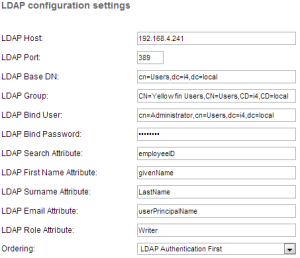Overview
Yellowfin can be connected to an LDAP source for user authentication and group management purposes. This allows Yellowfin access to be controlled externally and organisation-wide simply and quickly. Users can use their existing intranet password for Yellowfin authentication, and reports can be given access restrictions which include or exclude users in specific LDAP groups.
Yellowfin has the option to reference an external directory (LDAP) or database to perform authentication or an entered User ID without Single Sign On. This means that a user will have the same User ID and Password across all participating applications that use the directory. In addition, removal/lockout of the user on the directory will automatically flow through to Yellowfin, minimising the manual effort of managing users.
Preparing LDAP Integration
Prior to setting up the LDAP parameters in Yellowfin, the following will have to be completed:
- Create a Yellowfin User (or specify an existing user) within the LDAP to allow Yellowfin to connect and search for Users and Groups.
- Create a 'Yellowfin User' Group within LDAP (or specify one) which will be used to determine which users within LDAP will have access to Yellowfin.
- Ensure network connectivity between the Yellowfin server and the LDAP server.
- Define the default Yellowfin Role for LDAP users.
Defining the Default Role
For Yellowfin to provision users automatically it has to assign a role to them. This role is defined as a Yellowfin 'Default' Role. In the ロール page, define one Role as the Default.
- Navigate to Administration > General > Role Management
- Select the Role you wish to make Default
- Tick the Default Role box and Save
Note: if no role is set as default the users will not be provisioned correctly into Yellowfin and the process will fail.
Users Provisioning and Sign On
To provision users from the LDAP directory and to use LDAP Authentication the required attributes must be defined on the システム構成 page. The attributes required by Yellowfin include:
Property |
Description |
|---|---|
LDAP Host |
LDAP server hostname or IP address |
LDAP Port |
TCP/IP port that the LDAP server is listening on |
LDAP Base Distinguishing Name |
Base DN under which all Yellowfin Users and Groups are connected |
LDAP Yellowfin User Group |
LDAP Group Name that identifies which users can log into Yellowfin. This group exists in the LDAP directory, not Yellowfin. |
LDAP Binding User |
This is an LDAP User that the Yellowfin application uses to connect to the LDAP directory for search access |
LDAP Binding User Password |
The LDAP Password required for the Yellowfin application to connect to the LDAP directory |
LDAP Search Attribute |
This is a unique User Name field that LDAP users will login to Yellowfin with |
LDAP First Name Attribute |
This maps to the First Name attribute of the user within the LDAP directory. This is so Yellowfin can match the user to a name and create an internal user account. |
LDAP Surname Attribute |
This maps to the surname attribute of the user within the LDAP directory. This is so that Yellowfin can match the user to a name and create an internal user account. |
LDAP Email Attribute |
This maps to the email address attribute of the user within the LDAP directory. This is so that Yellowfin can match the user to an email address for broadcast reports. |
LDAP Role Attribute |
This maps to a Yellowfin Role to be assigned to the user instead of the Default Role. |
Once defined, Yellowfin will automatically provision users as they attempt to login to Yellowfin for the first time.
Note: if the users in LDAP exceed the number of licences purchased, any new users will not be provisioned into the system.
Example
This is an example taken from the システム構成 page of Yellowfin
The configuration above will:
- Connect to LDAP host
192.168.4.241on port389 - Users will be searched from
cn=Users,dc=i4,dc=local - Users will be allowed access to Yellowfin if they are a member of
cn=Yellowfin Users,cn=Users,dc=i4,dc=local - The user search is conducted with user
cn=Administrator,cn=Users,dc=i4,dc=localbound to the LDAP server with passwordpassword - Users will use
employeeIDas their login ID and Yellowfin will load their given name, surname, and email from the LDAP directory attributesgivenName,LastName, anduserPrincipalNamerespectively
Note: if a user is not found in the LDAP directory, it will look for the username as a standard Yellowfin user.
Using LDAP Groups for Yellowfin Security
Once LDAP Authentication is enabled, the Group Management screens will include a new group option called LDAP. This will source groups from the LDAP directory for use as normal Yellowfin Groups. Yellowfin Groups can also be created based on a variety of sources including mixtures of LDAP and Yellowfin groups, where LDAP groups can be either included or excluded in the new group.
- Open the Add LDAP Group drop down
- A list of LDAP groups will be displayed. Select the group to be used to create members for the Yellowfin Group
- Click Add to add the LDAP Group members into the Yellowfin Group

